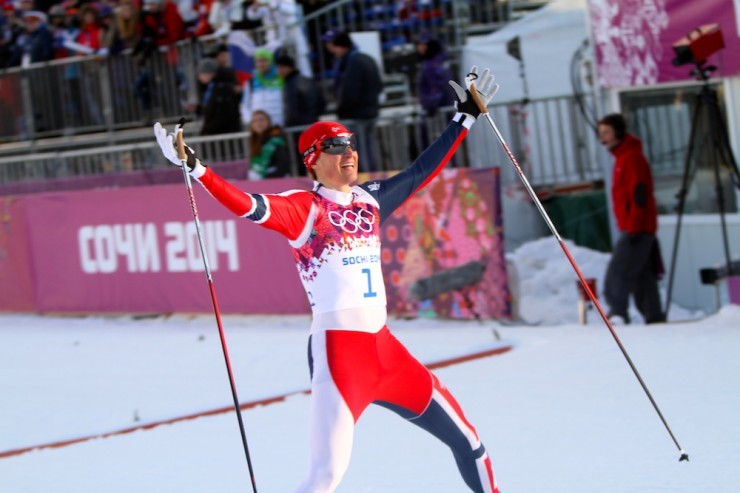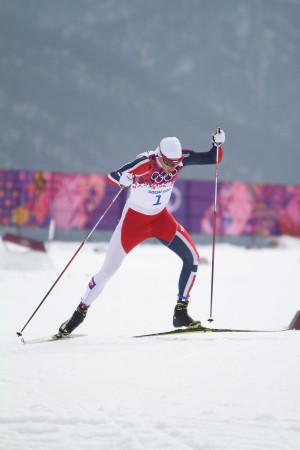
FasterSkier’s coverage is made possible through the generous support of Rudy Project.
SOCHI, Russia — At the start line of Tuesday’s Olympic sprint final, Norwegian Ola Vigen Hattestad thought back four years, to when he was standing on another start line, at the Vancouver games in 2010.
In that race—the last Olympic sprint final—he was caught flat-footed when a pair of Russian skiers slammed on the gas right from the gun and skied away to gold and silver, as two of their chasers crashed out and Hattestad ended up fourth.
In this Olympics, Hattestad resolved that the race would go differently.
“I was really thinking about it now, standing on the start line in the final,” Hattestad said. “I wanted to control this race. I don’t want to be behind.”
He did, getting himself to the front of the pack in time to avoid a messy pileup on a nasty downhill corner that took out half of the men’s field, evoking memories of Vancouver.

The crash left Hattestad to duel with just one other man, Sweden’s Teodor Peterson—a duel that ended with the Norwegian finishing with enough of a lead that he could raise both arms in celebration before crossing the line.
“It’s a great feeling to succeed in the Olympics,” Hattestad said. “It’s been a career gold for me, to take a medal.”
Twenty seconds behind Hattestad and Peterson, another Swede, Emil Joensson, tore to the finish, arriving just in time to earn a bronze that could end up being the most improbable medal awarded in this entire games.
Joenssen had been suffering from a back strain this week and had given up on a podium finish almost as soon as the gun went off.
He was trailing the pack by a huge margin when he came into the final downhill corner, where he swept past the three skiers who had crashed: one of his own teammates, plus a Russian and another Norwegian.
“I didn’t know how many they were, that were lying there,” Joensson said afterwards. “But I came to the big curve there, and up the last hill, and I heard a guy was in back of me, and I heard the Swedish coaches screaming that I’m going for a medal. And I was just giving everything I had.”
The end result was the hardware that has eluded Joensson, who is perennially one the world’s best sprinters, for years.
“Right now, I don’t know if I’m going to be happy, or if I’m going to be (sad),” he said. “It was really winning a lottery.”
A lottery does seem like the best metaphor for Tuesday’s sprint races, which saw multiple crashes take out some of the contenders on the men’s side—while on the women’s side, heavyweight Marit Bjoergen fell in a preliminary heat, and favorite Kikkan Randall was inexplicably outskied and failed to even qualify for the semifinals.
Sprinting is always unpredictable, but the white-knuckle corner on the men’s course added an extra level of chaos on Tuesday.
Warm temperatures at the Laura Cross-Country Ski Center on Monday night left the race organizers coping with sloppy conditions on Tuesday.
They spread salt on uphill sections of the course to make them more firm, but the downhill righthander leading into the last climb remained a sloppy, treacherous mess. (The organizers didn’t salt those areas because they didn’t want athletes to fall onto a harder surface, according to Pierre Mignerey, the cross-country race director for the International Ski Federation.)
Several spectacular crashes ensued before the final—one involving Switzerland’s Dario Cologna, and another in which a Russian athlete broke a ski. A Chinese skier had to be taken out of the venue on a stretcher.
In the finals, Hattestad had stuck to his plan and was leading a pack of five—minus Joensson—through the corner.
Both Hattestad and Peterson, who was close behind, skied it cleanly. But the next athlete to enter the turn, Norway’s Anders Gloeersen, slipped and fell, and the skier behind him, Sweden’s Marcus Hellner, fell too.
They both slid to the outside of the corner, directly into the path of Russia’s Sergey Ustiugov, who got taken out at the knees.
Joensson was the last man standing, as Hattestad and Peterson skied off to gold and silver.
Joensson’s performance was still Olympic in one sense—he was so exhausted and in so much pain from his strained back at the finish that he had to be helped away.
At a press conference afterward, Hattestad said he felt bad “for those who ended their day” on the corner. But he noted that the organizers had scraped excess snow from the turn, and added: “I don’t know if they can do anything more.”
“I guess, it is sprint racing,” he said.
In a phone interview, Mignerey, the race director, referred to the corner in the same way.
“It’s one part of the game,” he said. “Cross-country skiing is also to be able to be fast in downhills—even in hard downhills, curves.”
But, he added, “the men’s final today—it’s too much, for sure,” and he said he wanted to see some changes to the corner before the team sprint later in the games.
“Joensson almost gave up after the first uphill, (and) at the end he has a medal,” Mignerey said. “Not, sportwise, the best thing we can have.”
Nathaniel Herz
Nat Herz is an Alaska-based journalist who moonlights for FasterSkier as an occasional reporter and podcast host. He was FasterSkier's full-time reporter in 2010 and 2011.



